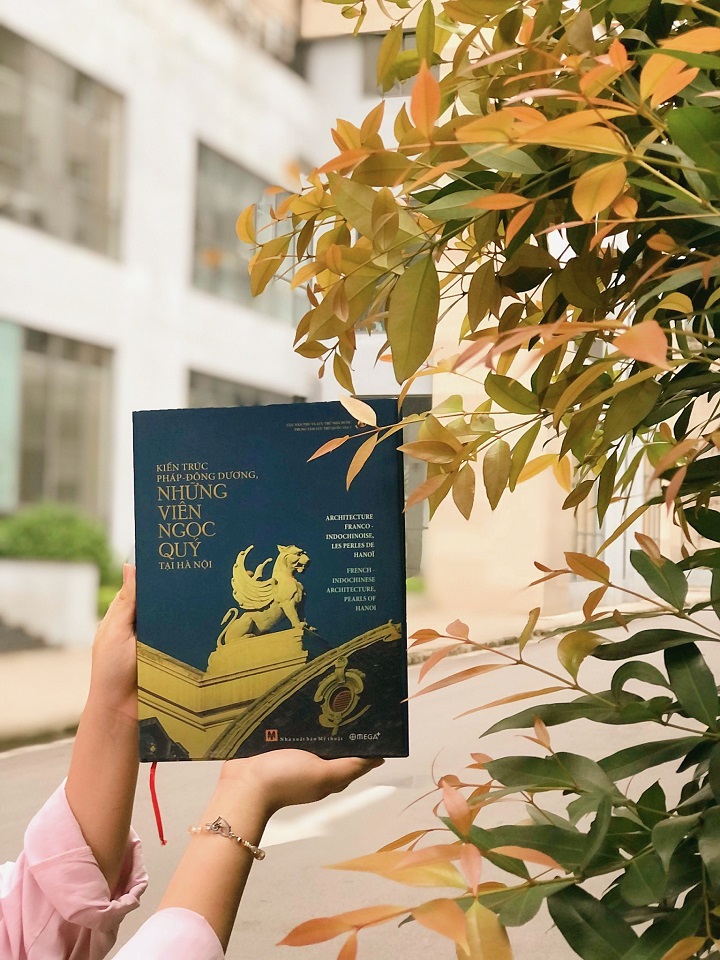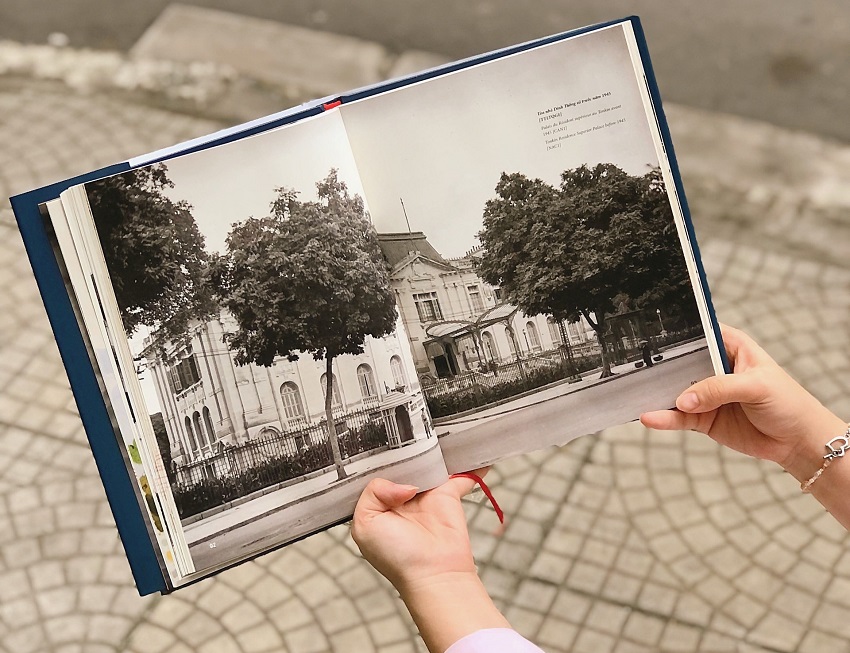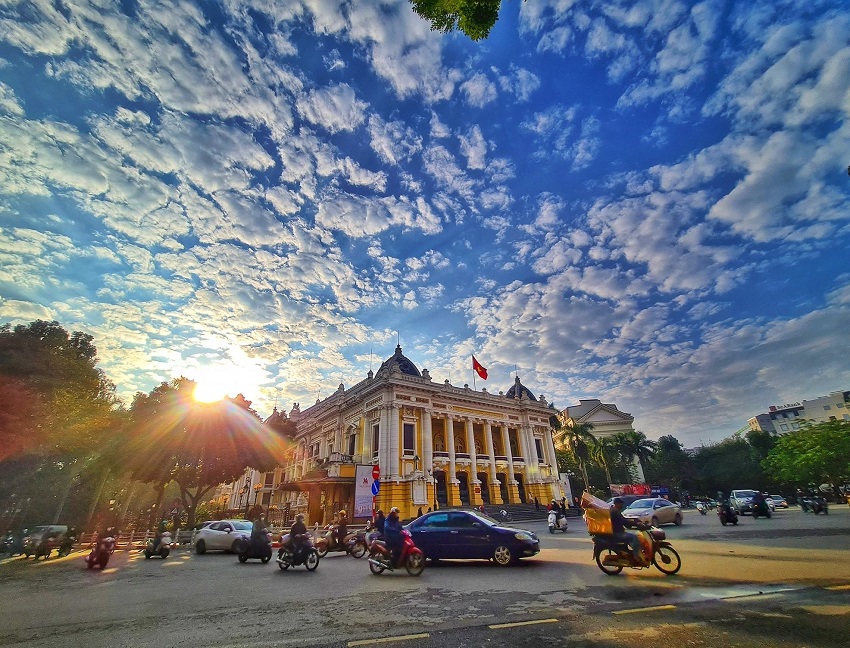Exploring the Grandeur of Hanoi’s French-Indochinese Architecture Through a Book
The book “French-Indochinese Architecture, Pearls of Hanoi” was co-published by Omega Book JSC and the National Archives Center I to commemorate the 50th anniversary of diplomatic relations between Vietnam and France.
| The cover of the trilingual Vietnamese-French-English book “French-Indochinese Architecture, Pearls of Hanoi” by Tran Huu Phuc Tien. Photo: Omega Plus |
The author of the book extends a warm invitation to readers to embark on a captivating journey through the pages, allowing them to explore 37 exquisite examples of French-Indochinese architectural marvels, exquisitely arrayed throughout the charming city of Hanoi. Commencing from the iconic Ba Dinh Square, the political nucleus of the city, this literary odyssey takes readers on an enchanting voyage, culminating at the remarkable Long Bien Bridge.
The premium “photo book” is a hardcover edition with 300 pages. Made with high-quality materials, it features a large paper size and comes with a dust jacket.
Architecture in Ba Dinh and Tay Ho Districts
Ba Dinh and Tay Ho districts in Hanoi showcase a blend of traditional and modern architectural styles. These districts are home to a diverse range of buildings, including government offices, embassies, and residential areas. The architecture in Ba Dinh and Tay Ho districts is characterized by grandeur and elegance, making it a popular destination for locals and tourists alike.
Architecture in Hoan Kiem District
Hoan Kiem district in Hanoi is known for its historical significance and architectural beauty. The district is home to many iconic landmarks, such as the Hoan Kiem Lake, the Hanoi Opera House, and the St. Joseph’s Cathedral. The architecture in Hoan Kiem district is a mix of French colonial and traditional Vietnamese styles, creating a unique and captivating atmosphere.
Architecture in Hai Ba Trung and Dong Da Districts
Hai Ba Trung and Dong Da districts in Hanoi are vibrant and dynamic areas with a rich architectural heritage. These districts feature a combination of residential buildings, commercial complexes, and historical sites. The architecture in Hai Ba Trung and Dong Da districts reflects Hanoi’s urban development and cultural diversity, offering visitors a glimpse into the city’s past and present.
Architecture in the Old Quarter and Red River Banks
The Old Quarter and Red River banks in Hanoi are known for their charming and picturesque architecture. The Old Quarter is a maze of narrow streets and ancient houses, preserving the traditional Vietnamese architectural style. The Red River banks offer a stunning waterfront view, lined with modern skyscrapers and luxurious residential complexes. Together, these areas showcase the juxtaposition of old and new architectural styles in Hanoi.
Non-intact Buildings
Hanoi also has a number of non-intact buildings that hold historical and cultural significance. These buildings, although partially destroyed or damaged, still reflect important episodes in Hanoi’s history. Efforts are being made to preserve and restore these non-intact buildings, ensuring the city’s architectural heritage is safeguarded for future generations.
The book on Hanoi stands out from previous architectural publications by offering more than just technical drawings. It features a comprehensive collection of archival photographs and a trilingual narrative text in Vietnamese, French, and English. Journalist Tran Huu Phuc Tien, a respected scholar and writer, has meticulously compiled this content for a truly informative and captivating reading experience.
The term “French-Indochinese Architecture, Pearls of Hanoi” is used to describe a collection of exceptional architectural structures in Hanoi. These include renowned landmarks like the Hanoi Opera House, the Presidential Palace, the National Institute of Hygiene and Epidemiology (also known as Pasteur Institute), and the Vietnam National Museum of History, amongst others. These buildings are considered significant gems due to their historical and cultural significance in Hanoi.
| Photo of the Tonkin Palace in the book.Photo: Omega Plus |
Historian Duong Trung Quoc has remarked that while there are numerous books on Hanoi’s architecture, this particular book stands out for its sophisticated and meticulous approach. The author employs a method of descriptive analysis, accompanied by photos and carefully selected documents, to provide a comprehensive exploration of the subject.
The book also highlights several less widely known but significant French architectural structures in Hanoi. These include the Nhan Dan newspaper headquarters and the historical 100-year-old villas located at 6 Hoang Dieu Street and 18 Ton Dan Street.
According to Tran Huu Phuc Tien, a renowned author and a native of Saigon, his first encounter with Hanoi did not take place until 1984. However, similar to other admirers of this ancient Vietnamese city, he was captivated by its unparalleled charm and its distinct fusion of French and Vietnamese influences.
As a non-expert in the field of architecture, I continue to fuel my passion for history,” he expressed.
The French influence is prominently showcased in Hanoi through its well-planned tree-lined streets that intersect at right angles, along with an abundance of parks, squares, and statues. This influence is also evident in the remarkable architecture of Hanoi’s pre-1945 public and private buildings, which were constructed in the neoclassical Beaux-Arts style. These buildings are distinguished by their grand and sophisticated facades,” he further elaborated.
| Typical French architecture in Hanoi – the Hanoi Opera House. Photo: Dung Dang |
The post Exploring the Grandeur of Hanoi’s French-Indochinese Architecture Through a Book appeared first on Vietexplorer.com.



Nhận xét
Đăng nhận xét